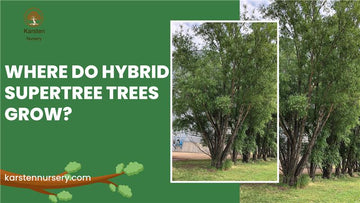
If you're searching for a tree that grows quickly and serves practical purposes like creating privacy or shielding against wind, you’ve likely heard about the hybrid supertree. This unique variety has captured the interest of homeowners, farmers, and landscapers alike for its remarkable adaptability. A frequent question we get is: where exactly can these trees thrive?
In this article, we’ll explore the environments where the hybrid supertree excels, drawing from hands-on experience and insights gained over years of cultivation. Whether you’re in a chilly northern state or a warmer southern region, knowing the right conditions can set you up for success.
Karsten Nursery has been growing and shipping these trees for over 40 years. Let’s dive into their preferred climates, soil types, and regional quirks to help you decide if a hybrid supertree is the right fit for your land.
What Makes the Hybrid Supertree Special?
Before we point out locations, let’s clarify what sets the hybrid supertree apart. Often called a hybrid willow tree, it’s a cross between the Chinese Willow and White Willow, carefully bred for fast growth and durability. It’s not a genetically modified species, just a thoughtfully selected clone for consistent traits.
These trees lead the pack in the fast-growing willow trees category, shooting up 6 to 8 feet per year when conditions are right. They’re perfect for forming hedges, windbreaks, or noise barriers.
Here at the nursery, we often hear folks ask about their origins. The hybrid supertree was developed in North America, particularly for Midwest farmers needing sturdy wind protection. In places like Iowa or Nebraska, these trees have been a go-to for shielding crops and livestock from harsh winds.
Where Does the Hybrid Supertree Thrive?

When it comes to weather, the hybrid supertree is very good at adapting. It grows well in USDA Hardiness Zones 3 through 9, which spans much of the U.S.—from the icy winters of North Dakota to the balmy summers of Georgia.
In colder zones, like Zone 3, they shrug off freezing temperatures, shedding leaves in fall but returning vibrant in spring. Their thick branches even catch snow, acting as a natural wind buffer during winter.
In warmer areas, they love the extended growing seasons but need a bit of extra care to establish roots. We’ve shipped to customers in Canada who rave about their cold-weather performance. But can they handle scorching heat? With regular watering, they can hold their own in hotter climates, though they’re not true desert plants.
For those more curious about the climate for hybrid supertrees, they prefer moderate rainfall—about 20 to 40 inches annually—but can adapt to drier areas with irrigation. Extreme arid zones, however, require a commitment to consistent watering, as their roots demand moisture to fuel rapid growth.
Also Read : How Long Do Crabapple Trees Live?
Soil Types: From Heavy Clay to Sandy Grounds

Soil is the foundation of a healthy tree. Fortunately, the hybrid supertree isn’t fussy. It grows in heavy clay, loamy blends, sandy soils, and even rocky patches. At Karsten Nursery, we’ve seen them take hold in less-than-ideal conditions—sometimes they’d root in gravel if given half a chance.
For the best soil for a hybrid supertree, aim for well-draining ground to avoid soggy roots. If your soil is poor, like dense clay or loose sand, mix in some compost, about a 50/50 blend with native dirt, when planting. This gives the roots a head start without much fuss. They can tolerate slightly acidic to neutral pH, making them a great pick for hybrid supertree farming across varied landscapes.
In sandy fields out west, they’ve helped stabilize soil against erosion while providing shade. Just keep in mind: while they handle poor soil well, regular watering in the early months is also very important.
Planting Tips for Maximum Growth
To help your hybrid supertree succeed wherever you plant it, follow a straightforward hybrid willow tree planting guide. Start with bare root stock or rooted plugs from our nursery, shipped fresh to your door. Dig a hole twice the width of the roots, plant at the same depth as they grew, and water slowly—about a gallon per tree weekly for the first three months.
For spacing, use 5 to 6 feet apart for a single-row windbreak or stagger two rows 8 to 10 feet apart for a denser barrier. Protect young trees from deer with a repellent like PlantSkydd®, available on our site. Once established, they’re low-maintenance, needing no pruning and resisting most pests.
As for the hybrid willow tree root system, it’s fibrous and spreads wide but stays shallow, so it’s safe near buildings if planted 20 to 30 feet away. Unlike some wild willows, these hybrids don’t spread aggressively, thanks to their controlled breeding.
Final Thought
The Hybrid Supertree has earned its reputation as one of the most versatile and reliable fast-growing willow trees available today. From shielding farms in the Midwest to providing privacy in suburban neighborhoods, these trees adapt with remarkable ease. Their ability to grow in different soils, endure harsh winters, and flourish in warm summers makes them a practical choice for nearly any property owner. Unlike traditional willows, their controlled breeding reduces invasiveness while maintaining the rapid growth homeowners and farmers love.
If you’re looking for a tree that offers privacy, shade, wind protection, and long-term resilience, the Hybrid Supertree is a proven solution. With the right planting and watering routine, these trees will establish quickly and continue to thrive for decades. Whether you want a single row of natural fencing or a full-scale windbreak, this tree delivers consistent results.
Ready to transform your landscape? Order Hybrid Supertrees today from Karsten Nursery and enjoy fast shipping, reliable quality, and expert support every step of the way.
Frequently Asked Questions
Q1. Where do hybrid willow trees grow?
Hybrid willow trees thrive in USDA Hardiness Zones 3–9, covering most of North America. They perform well in rural farmland, suburban yards, and even semi-urban spaces.
Q2. What is a hybrid super tree?
A Hybrid Super Tree is a cross between the Chinese Willow and White Willow, bred specifically for fast growth, durability, and privacy benefits. Unlike genetically modified plants, these are naturally cloned hybrids.
Q3. Do hybrid willow trees spread?
Unlike wild willow species, hybrid willow trees are bred to stay controlled. They form neat clumps, and their shallow, fibrous root systems mean they won’t take over your land.
Q4. How fast do hybrid willow trees grow?
When planted in the right conditions, these trees can grow 6–8 feet per year, sometimes even more. At maturity, a full-grown hybrid willow tree reaches 40–50 feet.
Read More Relevant Blogs :





